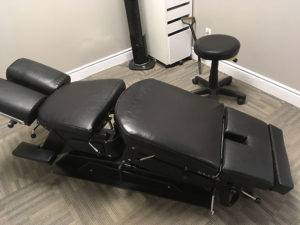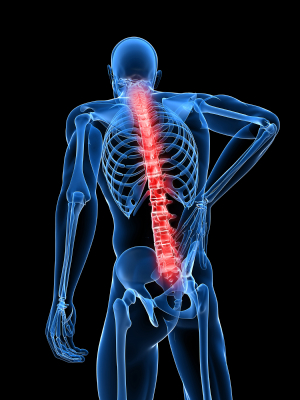
Chiropractic Treatment
Dr. McIntyre and Dr. McDowall are the owners and clinic directors of Burlington Sports Therapy.
They often use chiropractic spinal adjustments as a treatment method, but it really depends on the presenting condition. Your experience at Burlington Sports Therapy will begin with an initial examination. Following this, Dr. McIntyre or Dr. McDowall will discuss with you the nature or your condition and whether or not spinal adjustments would be beneficial. They will also discuss with you the risks and benefits of this approach. Should chiropractic adjustments not suit your comfort level, they will suggest to you other treatment options.

COMMON QUESTIONS
Chiropractors diagnose and treat injuries affecting the musculoskeletal system. That means, they treat injuries to the spine, pelvis, joints and muscles of the body. In a nutshell, they treat various physical injuries. It is a misconception that chiropractors only treat the spine. Chiropractors use various therapeutic modalities. The most common form of treatment provided by chiropractors involves manual therapy to the joints and soft tissues. An integral component of chiropractic care is the examination and diagnosis that occurs prior to treatment. Chiropractors are trained doctors with the specific ability to diagnose conditions related to the spine, pelvis, extremity joints and the nervous system.
Prior to being eligible for admission into Chiropractic College, students are required to complete a minimum of three years of university. The vast majority of chiropractic students have completed a four year University degree before entering Chiropractic College. The Canadian Memorial Chiropractic College curriculum consists of four years of full-time study, including a 12-month clinical internship.
Most Chiropractic curriculums include courses in anatomy, biochemistry, physiology, neurology, embryology, principles of chiropractic, radiology, immunology, microbiology, pathology, nutrition, and clinical sciences specifically relating to diagnosis.
Perhaps what really distinguishes Chiropractic education from most other health disciplines is the intensive training in Radiology. This area of study covers a range of topics from radiation biophysics and protection to clinical X-ray interpretation and diagnosis.
Radiology training in Chiropractic College consists of more than 360 contact hours followed by application during clinical internship. Chiropractic education also involves extensive hands-on clinical training under the supervision of highly-qualified faculty. This training includes clinical assessment, diagnosis, treatment, and referral protocols. The faculty members at both Canadian Chiropractic Colleges have diverse, highly qualified backgrounds. Faculty come from such disciplines as biological sciences, pathology, medicine and psychology as well as chiropractic.
The two Canadian Chiropractic Colleges have also formed relationships – both formal and informal – with various Universities in Canada.
Chiropractic care is commonly used to treat a variety of musculoskeletal conditions, primarily related to the spine and joints. Some of the conditions that chiropractic care may help treat include lower back pain and upper back pain, neck pain, headaches and migraines, whiplash injuries, sciatica, herniated or bulging disks, scoliosis, sports injuries, carpal tunnel syndrome, TMJ disorders, postural problems, chronic pain and arthritis.
During your first chiropractic visit at Burlington Sports Therapy, you can expect a thorough assessment to ensure the chiropractor understands your condition and can tailor a treatment plan. You will be asked about your medical history, lifestyle, past injuries, and specific symptoms you are experiencing. The chiropractor will want to understand your overall health to determine how it relates to your musculoskeletal system. Be prepared to explain where you are feeling pain or discomfort, when it started and what makes it better or worse. This assists the chiropractor in formulating a diagnosis. Following this thorough history, the chiropractor will perform a physical examination. They will assess your posture and observe how you move. They will have you perform simple movements to understand your range of motion, flexibility and identify any limitations you might have. The chiropractor will use their hands to feel for areas of tenderness or tightness in your spine and joints. This might include reflex checks, muscle strength tests, or other specialized assessments to rule out any nerve or joint issues. If necessary, your chiropractor might recommend diagnostic tests such as x-rays to get a clear picture of your spine or joints and rule out underlying conditions. This is usually not necessary, however.
After completing the evaluation, the chiropractor at Burlington Sports Therapy will discuss their findings with you. They will explain the issues they identified, how they might be contributing to your symptoms, and if chiropractic care can help. If chiropractic treatment is recommended, the chiropractor will outline a treatment plan, which may include adjustments, exercise or other therapies such as Graston, Shockwave, Active Release Technique (ART) or Laser Therapy. Your chiropractor will then discuss how often you might need to come in for further adjustments or treatments. For many people, chiropractic care requires a series of visits for maximum benefit, especially for chronic conditions. Our chiropractors at Burlington Sports Therapy can also provide advice on lifestyle changes, posture corrections, or at-home exercises that will support your healing process. The first visit is largely about understanding your condition and discussing a plan of management. At Burlington Sports Therapy, our chiropractors use various treatment approaches with their patients and ensure that everyone is comfortable with their type of therapy.
The number of chiropractic sessions you’ll need depends on several factors, including the severity of your condition, your overall health, and your treatment goals. If you are visiting one of our chiropractors for an acute condition (recent injuries or pain) you may need more frequent visits in the beginning, such as 2 – 3 sessions a week for the first few weeks. If you are being treated for a chronic condition such as back pain, arthritis or ongoing postural problems, treatment might take longer. You may need to be seen 1 – 2 times a week initially, then gradually taper to once every 2 – 4 weeks as your condition stabilizes. Some people choose to continue maintenance care on a regular basis (monthly) to prevent any further issues, but this is at the discretion of each patient. Your body’s response to treatment is a key factor in how many sessions you will need. Some people experience significant relief after just a few sessions, while others may need a longer course of treatment. Your Burlington Sports Therapy chiropractor will monitor your progress and adjust the treatment plan accordingly. If you’re feeling better, the frequency of sessions will reduce over time. Ultimately, the number of sessions varies from person to person. Your chiropractor will develop a treatment plan and adjust it as you progress, so it’s important to communicate openly about your symptoms and any changes you notice.
Yes, many insurance plans do cover chiropractic care, but the specifics can vary depending on your insurance provider, plan type, and location. Traditional health insurance plans offer coverage for chiropractic services, particularly for conditions like back pain, neck pain and headaches. Coverage typically includes adjustments and sometimes additional therapies, but there may be limits on the number of visits covered annually or co-pays for each session. Coverage is typically limited to a certain number of visits per year, and you may need to pay out-of-pocket for services beyond what your extended healthcare covers. If you have been in an auto accident, your auto insurance policy may cover chiropractic care. This is especially true if the chiropractic care is related to whiplash injury or other musculoskeletal problems resulting from the accident. Tips for checking coverage include calling your insurance provider, asking about coverage limits and checking for any additional costs.
Chiropractic treatment is generally considered safe, especially when performed by a licensed and experienced chiropractor. However, like any medical treatment, it can come with some side effects, although serious complications are rare. Most side effects tend to be mild and temporary, such as mild discomfort or soreness. To minimize risk, make sure to choose a licensed chiropractor, be open about your medical history, current conditions and any concerns you may have, especially if you have a history of disk issues, stroke risk or other serious health conditions. If you are newer to chiropractic care or have sensitive conditions, discuss starting with gentler care to minimize discomfort. If any unusual symptoms arise after treatment, don’t hesitate to reach out to your chiropractor at Burlington Sports Therapy for further evaluation.
Chiropractic care in Canada is distinct from other medical treatments primarily in its approach to diagnosing and treating health conditions. Chiropractors specialize in diagnosing and treating disorders related to the spine, muscles, joints and nervous system. Unlike conventional medicine, which often emphasizes pharmacological treatments such as medicine or surgeries, chiropractic care focuses on manual techniques, particularly spinal adjustments, to alleviate pain, improve function and promote overall health. At Burlington Sports Therapy, our chiropractors utilize soft tissue therapies like active release combined with home exercises and education on your diagnosis. Chiropractors often take a holistic approach, looking at the entire body and how different systems work together. They may consider lifestyle factors, posture, and ergonomics when treating a patient. Chiropractic care is a regulated healthcare profession, meaning chiropractors must meet specific educational and licencing requirements. They are governed by provincial regulatory bodies to ensure they meet professional standards, which adds a layer of accountability to their practice. This contrasts with alternative or complementary treatments that may not have the same level of regulations. Chiropractic care in Canada is increasingly supported by research and evidence, particularly for conditions like lower back pain, neck pain, and various musculoskeletal issues.
If you are in the Burlington, Oakville, Hamilton and surrounding areas and are in need of Chiropractic Treatment, contact Burlington Sports Therapy today.
One of the spinal mobilization approaches used by our chiropractors at Burlington Sports Therapy is called flexion-distraction, using what is called a Cox table. Although there is an actual “Cox Method” to treatment, we just use the table as our tool for encouraging lumbar mobility. When using this table, the patient lies on their stomach while the practitioner holds the lumbar spine and pivots the bottom end of the table from side to side and up and down. The purpose is to improve the patient’s lumbar mobility without using a high-velocity thrust. Perhaps an easy way to understand the purpose, the flexion-distraction table allows the practitioner to gently encourage motion at each level of the lower back so that the patient’s spine moves more like an accordion and less like a door hinge.
Chiropractic treatment is often used to improve muscle and joint conditioning, which has an obvious effect on athletic performance. Chiropractic treatment helps to fine-tune athletes. It assists their muscle and joint function and can help reduce long term wear and tear on the muscles and joints. Chiropractic treatment can prevent injuries and speed up recovery time. Although most people select chiropractic care to treat their injuries, many athletes choose chiropractic to improve athletic performance. The treatment approach may be similar in both of these cases; a treatment plan should be outlined for every patient.
In the case of professional and elite athletes, chiropractors often work in conjunction with other health care professionals including medical doctors, sports medicine doctors, massage therapists, physiotherapists, acupuncturists and athletic therapists. At Burlington Sports Therapy our Burlington Chiropractors often collaborate with various nearby health professionals. If you are in the Burlington, Oakville, Hamilton and surrounding areas and are looking for Chiropractic Treatment, call our office today.
Yes, children and pregnant women can receive chiropractic care, but there are some important considerations to ensure their safety and well-being. Chiropractic care for children is generally safe when performed by a chiropractor who is trained in pediatric care. At Burlington Sports Therapy, our chiropractors do not treat babies or toddlers, but we assist many young athletes and younger patients in diagnosing their injuries and ensuring proper development of the spine and joints.
For pregnant women, chiropractic care can also be safe and beneficial, provided it is performed by a chiropractor who is experienced in working with expectant mothers. Pregnancy brings changes to the body that can lead to discomfort or misalignment of the spine and pelvis. Chiropractic care can help alleviate back pain, pelvic pain, sciatica and neck and shoulder pain.
When looking for a chiropractor, it’s important to make sure they have the right qualifications and credentials to ensure you’re receiving safe and effective care. In Canada, Chiropractors must be licensed and registered with a provincial regulatory authority. Each province has its own regulatory body. You can verify a chiropractor’s registration through these bodies, such as the Canadian Chiropractic Association (CCA) or provincial associations like the Ontario Chiropractic Association or the British Columbia Chiropractic Association. Your chiropractor must complete a Doctor of Chiropractic (DC) program, which typically takes 4 years at an accredited chiropractic college. This program involves extensive training in anatomy, physiology, diagnostic skills and chiropractic techniques. Your chiropractor must pass national examinations to practice. The Canadian Chiropractic Examining Board (CCEB) conducts these exams, which assess the chiropractor’s clinical skills, knowledge, and ability to diagnose and treat various musculoskeletal conditions. Many provinces require chiropractors to complete continuing education courses regularly to maintain their certification and stay updated on the latest treatment techniques.
Chiropractors diagnose and treat injuries affecting the musculoskeletal system. That means, they treat injuries to the spine, pelvis, joints and muscles of the body. In a nutshell, they treat various physical injuries. It is a misconception that chiropractors only treat the spine. Chiropractors use various therapeutic modalities. The most common form of treatment provided by chiropractors involves manual therapy to the joints and soft tissues. An integral component of chiropractic care is the examination and diagnosis that occurs prior to treatment. Chiropractors are trained doctors with the specific ability to diagnose conditions related to the spine, pelvis, extremity joints and the nervous system.
Prior to being eligible for admission into Chiropractic College, students are required to complete a minimum of three years of university. The vast majority of chiropractic students have completed a four year University degree before entering Chiropractic College. The Canadian Memorial Chiropractic College curriculum consists of four years of full-time study, including a 12-month clinical internship.
Most Chiropractic curriculums include courses in anatomy, biochemistry, physiology, neurology, embryology, principles of chiropractic, radiology, immunology, microbiology, pathology, nutrition, and clinical sciences specifically relating to diagnosis.
Perhaps what really distinguishes Chiropractic education from most other health disciplines is the intensive training in Radiology. This area of study covers a range of topics from radiation biophysics and protection to clinical X-ray interpretation and diagnosis.
Radiology training in Chiropractic College consists of more than 360 contact hours followed by application during clinical internship. Chiropractic education also involves extensive hands-on clinical training under the supervision of highly-qualified faculty. This training includes clinical assessment, diagnosis, treatment, and referral protocols. The faculty members at both Canadian Chiropractic Colleges have diverse, highly qualified backgrounds. Faculty come from such disciplines as biological sciences, pathology, medicine and psychology as well as chiropractic.
The two Canadian Chiropractic Colleges have also formed relationships – both formal and informal – with various Universities in Canada.
One of the spinal mobilization approaches used by our chiropractors at Burlington Sports Therapy is called flexion-distraction, using what is called a Cox table. Although there is an actual “Cox Method” to treatment, we just use the table as our tool for encouraging lumbar mobility. When using this table, the patient lies on their stomach while the practitioner holds the lumbar spine and pivots the bottom end of the table from side to side and up and down. The purpose is to improve the patient’s lumbar mobility without using a high-velocity thrust. Perhaps an easy way to understand the purpose, the flexion-distraction table allows the practitioner to gently encourage motion at each level of the lower back so that the patient’s spine moves more like an accordion and less like a door hinge.
Many athletes use chiropractic care. At major sporting events like the Olympics, Chiropractors are an integral part of the core medical team. Additionally, professional sports organizations usually have a Chiropractor as part of the health team for players.
Chiropractic treatment is often used to improve muscle and joint conditioning, which has an obvious effect on athletic performance. Chiropractic treatment helps to fine-tune athletes. It assists their muscle and joint function and can help reduce long term wear and tear on the muscles and joints. Chiropractic treatment can prevent injuries and speed up recovery time. Although most people select chiropractic care to treat their injuries, many athletes choose chiropractic to improve athletic performance. The treatment approach may be similar in both of these cases; a treatment plan should be outlined for every patient.
In the case of professional and elite athletes, chiropractors often work in conjunction with other health care professionals including medical doctors, sports medicine doctors, massage therapists, physiotherapists, acupuncturists and athletic therapists. At Burlington Sports Therapy our Burlington Chiropractors often collaborate with various nearby health professionals. If you are in the Burlington, Oakville, Hamilton and surrounding areas and are looking for Chiropractic Treatment, call our office today.
Chiropractic care is commonly used to treat a variety of musculoskeletal conditions, primarily related to the spine and joints. Some of the conditions that chiropractic care may help treat include lower back pain and upper back pain, neck pain, headaches and migraines, whiplash injuries, sciatica, herniated or bulging disks, scoliosis, sports injuries, carpal tunnel syndrome, TMJ disorders, postural problems, chronic pain and arthritis.
During your first chiropractic visit at Burlington Sports Therapy, you can expect a thorough assessment to ensure the chiropractor understands your condition and can tailor a treatment plan. You will be asked about your medical history, lifestyle, past injuries, and specific symptoms you are experiencing. The chiropractor will want to understand your overall health to determine how it relates to your musculoskeletal system. Be prepared to explain where you are feeling pain or discomfort, when it started and what makes it better or worse. This assists the chiropractor in formulating a diagnosis. Following this thorough history, the chiropractor will perform a physical examination. They will assess your posture and observe how you move. They will have you perform simple movements to understand your range of motion, flexibility, and identify any limitations you might have. The chiropractor will use their hands to feel for areas of tenderness or tightness in your spine and joints. This might include reflex checks, muscle strength tests, or other specialized assessments to rule out any nerve or joint issues. If necessary, your chiropractor might recommend diagnostic tests such as x-rays to get a clear picture of your spine or joints and rule out underlying conditions. This is usually not necessary, however.
After completing the evaluation, the chiropractor at Burlington Sports Therapy will discuss their findings with you. They will explain the issues they identified, how they might be contributing to your symptoms, and if chiropractic care can help. If chiropractic treatment is recommended, the chiropractor will outline a treatment plan, which may include adjustments, exercise or other therapies such as Graston, Shockwave, Active Release Technique (ART) or Laser Therapy. Your chiropractor will then discuss how often you might need to come in for further adjustments or treatments. For many people, chiropractic care requires a series of visits for maximum benefit, especially for chronic conditions. Our chiropractors at Burlington Sports Therapy can also provide advice on lifestyle changes, posture corrections, or at-home exercises that will support your healing process. The first visit is largely about understanding your condition and discussing a plan of management. At Burlington Sports Therapy, our chiropractors use various treatment approaches with their patients and ensure that everyone is comfortable with their type of therapy.
The number of chiropractic sessions you’ll need depends on several factors, including the severity of your condition, your overall health, and your treatment goals. If you are visiting one of our chiropractors for an acute condition (recent injuries or pain) you may need more frequent visits in the beginning, such as 2 – 3 sessions a week for the first few weeks. If you are being treated for a chronic condition such as back pain, arthritis or ongoing postural problems, treatment might take longer. You may need to be seen 1 – 2 times a week initially, then gradually taper to once every 2 – 4 weeks as your condition stabilizes. Some people choose to continue maintenance care on a regular basis (monthly) to prevent any further issues, but this is at the discretion of each patient. Your body’s response to treatment is a key factor in how many sessions you will need. Some people experience significant relief after just a few sessions, while others may need a longer course of treatment. Your Burlington Sports Therapy chiropractor will monitor your progress and adjust the treatment plan accordingly. If you’re feeling better the frequency of sessions will reduce over time. Ultimately, the number of sessions varies from person to person. Your chiropractor will develop a treatment plan and adjust it as you progress, so it’s important to communicate openly about your symptoms and any changes you notice.
Yes, many insurance plans do cover chiropractic care, but the specifics can vary depending on your insurance provider, plan type, and location. Traditional health insurance plans offer coverage for chiropractic services, particularly for conditions like back pain, neck pain and headaches. Coverage typically includes adjustments and sometimes additional therapies, but there may be limits on the number of visits covered annually or co-pays for each session. Coverage is typically limited to a certain number of visits per year, and you may need to pay out-of-pocket for services beyond what your extended healthcare covers. If you have been in an auto accident, your auto insurance policy may cover chiropractic care. This is especially true if the chiropractic care is related to whiplash injury or other musculoskeletal problems resulting from the accident. Tips for checking coverage include calling your insurance provider, asking about coverage limits and checking for any additional costs.
Chiropractic treatment is generally considered safe, especially when performed by a licensed and experienced chiropractor. However, like any medical treatment, it can come with some side effects, although serious complications are rare. Most side effects tend to be mild and temporary, such as mild discomfort or soreness. To minimize risk, make sure to choose a licensed chiropractor, be open about your medical history, current conditions and any concerns you may have, especially if you have a history of disk issues, stroke risk or other serious health conditions. If you are newer to chiropractic care or have sensitive conditions, discuss starting with gentler care to minimize discomfort. If any unusual symptoms arise after treatment, don’t hesitate to reach out to your chiropractor at Burlington Sports Therapy for further evaluation.
Chiropractic care in Canada is distinct from other medical treatments primarily in its approach to diagnosing and treating health conditions. Chiropractors specialize in diagnosing and treating disorders related to the spine, muscles, joints and nervous system. Unlike conventional medicine, which often emphasizes pharmacological treatments such as medicine or surgeries, chiropractic care focuses on manual techniques, particularly spinal adjustments, to alleviate pain, improve function and promote overall health. At Burlington Sports Therapy, our chiropractors utilize soft tissue therapies like active release combined with home exercises and education on your diagnosis. Chiropractors often take a holistic approach, looking at the entire body and how different systems work together. They may consider lifestyle factors, posture, and ergonomics when treating a patient. Chiropractic care is a regulated healthcare profession, meaning chiropractors must meet specific educational and licensing requirements. They are governed by provincial regulatory bodies to ensure they meet professional standards, which adds a layer of accountability to their practice. This contrasts with alternative or complementary treatments that may not have the same level of regulations. Chiropractic care in Canada is increasingly supported by research and evidence, particularly for conditions like lower back pain, neck pain, and various musculoskeletal issues.
Yes, children and pregnant women can receive chiropractic care, but there are some important considerations to ensure their safety and well-being. Chiropractic care for children is generally safe when performed by a chiropractor who is trained in pediatric care. At Burlington Sports Therapy, our chiropractors do not treat babies or toddlers; however, we assist many young athletes and younger patients in diagnosing their injuries and ensuring the proper development of their spines and joints.
For pregnant women, chiropractic care can also be safe and beneficial, provided it is performed by a chiropractor who is experienced in working with expectant mothers. Pregnancy brings changes to the body that can lead to discomfort or misalignment of the spine and pelvis. Chiropractic care can help alleviate back pain, pelvic pain, sciatica and neck and shoulder pain.
When looking for a chiropractor, it’s important to make sure they have the right qualifications and credentials to ensure you’re receiving safe and effective care. In Canada, Chiropractors must be licensed and registered with a provincial regulatory authority. Each province has its own regulatory body. You can verify a chiropractor’s registration through these bodies, such as the Canadian Chiropractic Association (CCA) or provincial associations like the Ontario Chiropractic Association or the British Columbia Chiropractic Association. Your chiropractor must complete a Doctor of Chiropractic (DC) program, which typically takes 4 years at an accredited chiropractic college. This program involves extensive training in anatomy, physiology, diagnostic skills and chiropractic techniques. Your chiropractor must pass national examinations to practice. The Canadian Chiropractic Examining Board (CCEB) conducts these exams, which assess the chiropractor’s clinical skills, knowledge, and ability to diagnose and treat various musculoskeletal conditions. Many provinces require chiropractors to complete continuing education courses regularly to maintain their certification and stay updated on the latest treatment techniques.
If you are in the Burlington, Oakville, Hamilton and surrounding areas and are in need of Chiropractic Treatment, contact Burlington Sports Therapy today.
YOUR FIRST VISIT

Your Burlington Chiropractor at Burlington Sports Therapy will perform a proper health history and examination prior to treatment. This will usually require a minimum of 30 minutes. This may include questions about your personal and family medical history, major illnesses you have experienced, previous surgeries and current medications. Your chiropractor will ask you questions about your current condition and the steps you have taken to alleviate it.
It is a great idea to bring comfortable clothes and shoes for your visit to the chiropractor, but you may be asked to change into a gown to perform some tests. These tests may include a check of your blood pressure, pulse and breathing, a test of your reflexes, strength and sensations and an analysis of your posture.
At our Burlington Chiropractic Clinic, we often refer patients for X-rays to local medical X-ray facilities. Your chiropractic examination will include an analysis of your movement. Your chiropractor will evaluate how your spine moves and will identify areas of improper joint movement. Your initial examination will also involve orthopedic testing. These are tests in which the chiropractor will move different joints of your body in an effort to diagnose your condition. Following your examination, your chiropractor will make a diagnosis, prescribe a course of treatment, and once the matter of informed consent has been discussed, treatment usually commences.
Your chiropractor will refer you to an alternate practitioner should your condition be better treated by someone else. Our Burlington Chiropractors usually require 10 to 15 minutes for subsequent treatment visits. This duration will obviously depend on the type of treatment you require.


Getting a Second Opinion on X-rays
Rocket Digital2024-04-30T16:44:00-04:00April 30, 2024|
By: Dr. Kevin McIntyre B.Kin., DC Seeing a chiropractor is not just about getting treatment. Chiropractors are primary care experts who [...]
Do I need an x-ray for back pain?
Rocket Digital2024-12-13T09:59:57-05:00May 25, 2017|
When do you need an x-ray for back pain? This is a question I get asked on a regular basis. [...]
Back Pain and Neck Pain in Burlington
Rocket Digital2023-11-27T10:40:47-05:00August 4, 2013|
It seems that the longer I’m in practise, the more I appreciate the negative impact prolonged sitting can have on [...]
Dr. Kevin McIntyre is an extremely knowledgeable Chiropractor. Due to this knowledge, he brings alternative methods of care to his patients. As a runner, this is critical for me when I need to ensure that my areas of improvement can’t be addressed with just one method. Graston, A.R.T., and Chiropractic care have worked wonders on my IT band, knee and neck issues. Due to the great service and results from the Dr. McIntyre, I transferred my care over to him permanently. I really feel like I am taken care of and my needs and concerns are listened too and addressed. Today I am healed and I continue with my therapy as preventative maintenance. I am thrilled with the service provided and I would strongly recommend Dr. McIntyre service to anyone.
Let us help you reach your
full potential
Contact us today to book an appointment






